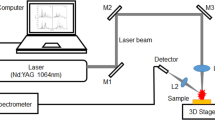Abstract
The aim of this work is to analyze the feasibility of artificial neural networks (ANN) for the classification, in function of the provenance, of archaeological ceramics Terra Sigillata analyzed by means of laser-induced breakdown spectroscopy (LIBS). In order to automate and facilitate the task of comparison of LIBS spectra, two ANN algorithms are proposed: One is fed with the whole LIBS spectra and the other with the areas of the most intense peaks of the spectra. In both cases, an analysis of the network architecture as a function of the number of hidden neurons and number of epochs of training was carried out in order to optimize the performance of the network. Following both procedures, the correct classification (higher than the 95% of success) of Terra Sigillata pieces from their LIBS spectra can be achieved in a systematic and objective way.
Similar content being viewed by others
References
M. Maggetti, Chimia 55, 923 (2001)
M.C. López-Pérez, El comercio de Terra Sigillata en la provincia de A Coruña, Brigantium, vol. 16 (Museo Arqueolóxico e Histórico Castelo de San Antón, A Coruña, 2004)
C. Fotakis, D. Anglos, V. Zafiropulos, S. Georgiou, V. Tornari, Lasers in the Preservation of Cultural Heritage (Taylor & Francis, Philadelphia, 2007)
A.J. López, G. Nicolás, M.P. Mateo, A. Ramil, V. Piñón, A. Yáñez, Appl. Phys. A 83, 695 (2006)
C.M. Bishop, Rev. Sci. Instrum. 65, 1803 (1994)
K.L. Peterson, Rev. Comput. Chem. 16, 53 (2000)
J.A. Remola, J. Lozano, I. Ruisanchez, M.S. Larrechi, F.X. Rius, J. Zupan, Trac-Trends Anal. Chem. 15, 137 (1996)
S. Bell, C. Crosom, Archaeometry 40, 139 (1998)
A. López-Molinero, A. Castro, J. Pino, J. Pérez-Arantegui, J.R. Castillo, Fresenius J. Anal. Chem. 367, 586 (2000)
Q.L. Maa, A. Yana, Z. Hu, Z. Lib, B. Fanc, Anal. Chim. Acta 406, 247 (2000)
P. Fermo, F. Cariati, D. Ballabio, V. Consonni, G. Bagnasco Gianni, Appl. Phys. A 79, 299 (2004)
R. Sattmann, I. Moench, H. Krause, R. Noll, R. Miguel, C. Fotakis, S.C.A. Hatziapostolou, A. Mavromanolakis, E. Larrauri, Appl. Spectrosc. 52, 456 (1998)
O. Samek, H.H. Telle, D.C. Beddows, BMC Oral Health 1, 1 (2001)
P. Inakollu, A study of the effectiveness of neural networks for elemental concentration from LIBS spectra (Thesis, Faculty of Mississippi State University, Mississippi, 2003)
J.B. Sirven, B. Bousquet, L. Canioni, L. Sarger, S. Tellier, M. Potin-Gautier, I. Le Hecho, Anal. Bioanal. Chem. 385, 256 (2006)
S. Haykin, Neural Networks: A Comprehensive Foundation (Prentice Hall, New Jersey, 1999)
F.M. Ham, I. Kostanic, Principles of Neurocomputing for Science and Engineering (McGraw Hill, New York, 2001)
A.J. López, G. Nicolás, M.P. Mateo, V. Piñón, M.J. Tobar, A. Ramil, Spectrochim. Acta B 60, 1149 (2005)
D.A. Cirovic, Trac-Trends Anal. Chem. 16, 148 (1997)
H. Demuth, M. Beale, M. Hagan, Neural Network Toolbox User’s Guide (The MathWorks, Inc., 1992–2007)
E.A. Hernández-Caraballo, L.M. Marcó-Parra, Spectrochim. Acta B 58, 2205 (2003)
Author information
Authors and Affiliations
Corresponding author
Additional information
PACS
84.35.+i; 42.62.Fi; 81.05.Je
Rights and permissions
About this article
Cite this article
Ramil, A., López, A. & Yáñez, A. Application of artificial neural networks for the rapid classification of archaeological ceramics by means of laser induced breakdown spectroscopy (LIBS). Appl. Phys. A 92, 197–202 (2008). https://doi.org/10.1007/s00339-008-4481-7
Received:
Accepted:
Published:
Issue Date:
DOI: https://doi.org/10.1007/s00339-008-4481-7




